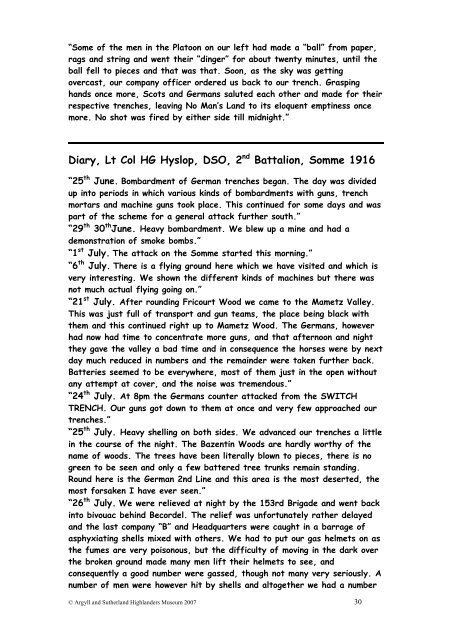The First World War - Historic Scotland
The First World War - Historic Scotland
The First World War - Historic Scotland
Create successful ePaper yourself
Turn your PDF publications into a flip-book with our unique Google optimized e-Paper software.
“Some of the men in the Platoon on our left had made a “ball” from paper,<br />
rags and string and went their “dinger” for about twenty minutes, until the<br />
ball fell to pieces and that was that. Soon, as the sky was getting<br />
overcast, our company officer ordered us back to our trench. Grasping<br />
hands once more, Scots and Germans saluted each other and made for their<br />
respective trenches, leaving No Man’s Land to its eloquent emptiness once<br />
more. No shot was fired by either side till midnight.”<br />
Diary, Lt Col HG Hyslop, DSO, 2 nd Battalion, Somme 1916<br />
“25 th June. Bombardment of German trenches began. <strong>The</strong> day was divided<br />
up into periods in which various kinds of bombardments with guns, trench<br />
mortars and machine guns took place. This continued for some days and was<br />
part of the scheme for a general attack further south.”<br />
“29 th 30 th June. Heavy bombardment. We blew up a mine and had a<br />
demonstration of smoke bombs.”<br />
“1 st July. <strong>The</strong> attack on the Somme started this morning.”<br />
“6 th July. <strong>The</strong>re is a flying ground here which we have visited and which is<br />
very interesting. We shown the different kinds of machines but there was<br />
not much actual flying going on.”<br />
“21 st July. After rounding Fricourt Wood we came to the Mametz Valley.<br />
This was just full of transport and gun teams, the place being black with<br />
them and this continued right up to Mametz Wood. <strong>The</strong> Germans, however<br />
had now had time to concentrate more guns, and that afternoon and night<br />
they gave the valley a bad time and in consequence the horses were by next<br />
day much reduced in numbers and the remainder were taken further back.<br />
Batteries seemed to be everywhere, most of them just in the open without<br />
any attempt at cover, and the noise was tremendous.”<br />
“24 th July. At 8pm the Germans counter attacked from the SWITCH<br />
TRENCH. Our guns got down to them at once and very few approached our<br />
trenches.”<br />
“25 th July. Heavy shelling on both sides. We advanced our trenches a little<br />
in the course of the night. <strong>The</strong> Bazentin Woods are hardly worthy of the<br />
name of woods. <strong>The</strong> trees have been literally blown to pieces, there is no<br />
green to be seen and only a few battered tree trunks remain standing.<br />
Round here is the German 2nd Line and this area is the most deserted, the<br />
most forsaken I have ever seen.”<br />
“26 th July. We were relieved at night by the 153rd Brigade and went back<br />
into bivouac behind Becordel. <strong>The</strong> relief was unfortunately rather delayed<br />
and the last company “B” and Headquarters were caught in a barrage of<br />
asphyxiating shells mixed with others. We had to put our gas helmets on as<br />
the fumes are very poisonous, but the difficulty of moving in the dark over<br />
the broken ground made many men lift their helmets to see, and<br />
consequently a good number were gassed, though not many very seriously. A<br />
number of men were however hit by shells and altogether we had a number<br />
© Argyll and Sutherland Highlanders Museum 2007 30













![Elgin Cathedral Wedding Brochure [pdf, 544kb] - Historic Scotland](https://img.yumpu.com/22301571/1/190x151/elgin-cathedral-wedding-brochure-pdf-544kb-historic-scotland.jpg?quality=85)



